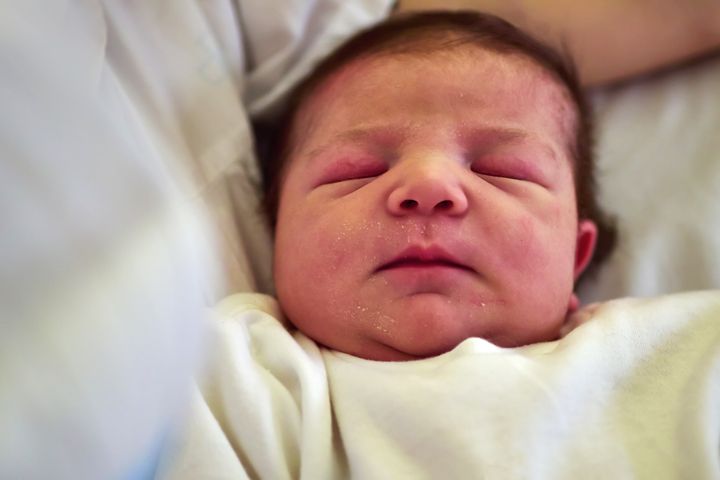
When you have a baby, you quickly realise that their skin is really having to make some big adjustments to life outside the womb.
It makes sense – they’ve spent a good nine months floating around in amniotic fluid, covered in vernix (the white, sticky substance you might’ve noticed on their skin when they were born) – their body’s very own way of keeping them moisturised.
And now, all of a sudden, they’re spending every waking breath in a completely different – not to mention, dry – environment. They’ll have random rashes pop up, bouts of dry skin, weird spots that look like they’ve hit their teen years a decade too early (yes, baby acne is a thing).
Oilatum’s expert dermatologist Dr Jean Ayer says there are three skin complaints in particular she sees a lot of in babies. Here’s what they are and how parents can help treat them at home.
1. Atopic eczema
If there’s one thing most parents are familiar with – whether through their own personal battles with it, their child’s or another family member’s – it’s eczema. In fact, up to 30% of children will end up with the skin disorder.
In babies, eczema usually starts on the scalp and face, “and they often have red, dry, scaly rashes on the cheeks, forehead, and around the mouth which can be wet and weepy as it gets more severe,” says Dr Ayer.
“The general texture of a baby’s skin should be smooth and soft, but in babies with eczema, one of the first signs a parent may notice is that the skin feels rough and dry to touch.”
The eczema often becomes more generalised and affects most other parts of the body in children with more severe skin disease, but in very young infants, it often spares the nappy area where moisture gets trapped by the nappy, and in turn protects the skin.
“Very young babies can’t itch their skin so instead pinch or grab it,” she adds.
In terms of treating it, parents should apply an emollient which repairs and restores the barrier function of skin. In some cases, you might be prescribed a topical steroid for particularly inflamed areas – if this is the case, Dr Ayer reminds to apply it daily.
“It’s key to avoid products with preservatives which can irritate already inflamed skin,” she adds.
“To help manage eczema symptoms, particularly in the evening, I would always recommend a nighttime tepid bath no warmer than 37 degrees with a good bath emollient. I suggest that they are allowed to splash and play in the bath for at least 15 minutes as this allows maximum absorption of the bath emollient.”
2. Cradle cap
This is another issue that’ll affect most children – according to Lancaster General Health it occurs in about 70% of babies.
“Cradle cap, otherwise known as infantile seborrheic dermatitis, is a very common, and is usually a self-remitting, non-inflammatory skin complaint that usually presents between the first 3 weeks to three months of life,” says Dr Ayer.
Typically, a baby will have a build-up of greasy, yellow scale on the top of their scalp – but cradle cap can also affect the face.
In this instance, it will look like red, scaly plaques on the forehead, eyebrows/eyelids, nasolabial folds, cheeks, and behind the ears, says the dermatologist.
“Occasionally other areas can be involved such as around the belly button and the nappy area,” she adds.
If your baby has cradle cap, it’s nothing to worry about. Dr Ayer recommends washing the baby daily with a gentle baby shampoo along with an emollient containing light liquid paraffin.
“Afterwards, gentle removal of scale with a soft toothbrush or cradle cap comb can be performed as the emollient will help soften the scale making the scales easier to remove,” she adds.
Once you’ve removed the scale, she recommends daily shampooing to prevent it from coming back.
3. Scabies
Scabies is another common issue – and anyone can get it. It’s caused by tiny mites that burrow into the skin. The key thing to remember here is that it should be treated quickly to stop it spreading, so you’ll need to speak to a pharmacist or GP about it.
“In babies the rash tends to be on the head, neck, palms, and soles and is intensely itchy. Overnight, the itching from scabies can often become much worse,” Dr Ayer explains.
“Appearance wise, the rash can look like little blisters or pimples but it’s important to note it can often take up to a month after infection to appear, as it takes this length of time for the scabies eggs to mature.”
In terms of treatment, babies will need a medicated cream – such as 5% permethrin cream – applied to their scalp, neck and over their whole body down to their toes, the dermatologist suggests.
“Usually treatment is required twice, with a week between each treatment. The itch can take up to six weeks to go away. This is usually because of an allergic response, not ongoing scabies, and can be treated with calamine lotion or an emollient,” she adds.
Your baby’s clothing, sheets, towels and soft toys should be washed on the hottest setting possible. Clothes and bedding should also be dried on the hottest setting (if you have a tumble dryer) to destroy the mites and their eggs.
“Around the house, vacuum all carpets and mattresses and also treat all family members at the same time, even if only one child is affected,” she adds.
And if you’re ever concerned about a rash or skin issue that’s impacting your baby, or you notice their skin problem is getting worse, always seek medical advice from your doctor, health visitor or dermatologist.